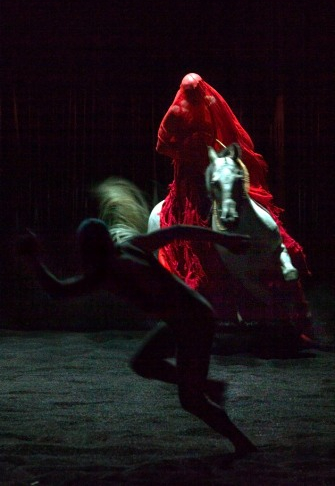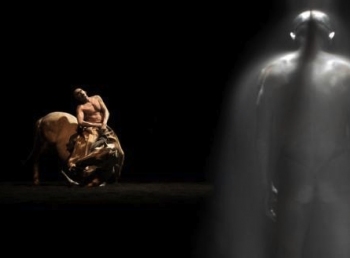The Centaur and the Animal, Sadler's Wells | reviews, news & interviews
The Centaur and the Animal, Sadler's Wells
The Centaur and the Animal, Sadler's Wells
Unforgettable theatrical imagery with horse and man and the theme of death
To achieve a black stage that emits or reflects no light is a hell of an achievement. To place a huge black horse with black rider onto that stage, without the slightest noise, and to contrive a black shadow on the black, is to create an image found in the fathomless wells of subconscious imagery, and the skill of that vision and realisation of it is something I doubt I'm going to forget.
The Centaur and the Animal is a very strange and potent piece of theatre at Sadler’s Wells this week uniting - if it were possible - the pessimism of Japanese butoh dance-theatre with the mystical grandeur of the rider on the horse, and the great and fearsome associations between them. The mythology of horses remains barely noticed in theatre, so difficult is it to put them on stage without being gimmicky, but the show's conceiver, Bartabas, has a phenomenal equestrian mastery and the imaginative power to use it.
 However, you can tell he's French. I’d call this a thrilling theatrical event if it weren’t for it being saddled (sorry) with a heavily distracting and blowsy voiceover of verbiage poétique. The problem is less the quality of the text, than that to listen to it intelligently fights the non-verbal senses required to process the images, and therefore the power of the event was - for me - ripped down the middle like a piece of paper torn in two.
However, you can tell he's French. I’d call this a thrilling theatrical event if it weren’t for it being saddled (sorry) with a heavily distracting and blowsy voiceover of verbiage poétique. The problem is less the quality of the text, than that to listen to it intelligently fights the non-verbal senses required to process the images, and therefore the power of the event was - for me - ripped down the middle like a piece of paper torn in two.
Words are murmured from first till last, a text oozing with images of sickness, corruption and decay. The English is not well enunciated and has enough of an accent to be a trial just to listen to through the patchy sound system. Swiftly giving up, I decided to ignore it and simply to blot up the extraordinary images and Jean Schwarz’s electronic noise soundscore. It worked for me, though I am told by colleagues who could hear better that the extracts of Lautréamont’s 1869 Les chants de Maldoror contained divertingly lurid images of vipers swallowing pricks, crabs in anuses, carbuncles, testicles, and all sorts of dactylic deliciousness.
Be that as it may, I was drawn down, down, down into this unnerving unreality, as Ko Murobushi, a tiny wiry old man, crawled and wriggled blindly and in extreme slow motion on the chalk-white frontage of the stage, while behind him in the sightless black vacuum Bartabas rode his horses like shadows of death.
The black-white contrast is somehow entirely lifeless, an impression paradoxically enhanced by the electronic fragments of drips, voices, echoes, last memories from the world. Powdered floors ensure not the slightest reflectivity or noise, on black or white. The stage is closed in with draped black curtains that can catch a fleck of light and undulate slipperily, like the gaping mouth walls of the Leviathan, or which disappear into nothing, leaving one in tomblike blackness, total absence of light, total disconnection with life.
Murobushi appears to be dreaming of approaching death, confronting the charging horseman of death in his fantasy, freezing in agonies of fear in reality. His little body is painted silver, and when at some point he upends himself naked on stage in a shoulder-stand, his head invisible from the front, it’s a terrible vision, a pewter statue of a man thrown like a dart into the white ground, petrified, headless, eyes underground. And behind him, in the black beyond, waits a shadowy centaur ready to collect his corpse, or a white, hooded Mongol khan on a magnificant, bull-necked warhorse.
 Bartabas melds into his steeds in shifting waves of materials, like cobwebs, shrouds or gigantic black wings. Sometimes his body seems to vanish and the horse appears riderless, borne on wings. Sometimes he is a man dying with his horse, collapsing over and over while Murobushi shivers under a shower of dust (pictured left). The images are broken out separately, stark enough and blurry enough in the darkness to draw each viewer to their own line of thought.
Bartabas melds into his steeds in shifting waves of materials, like cobwebs, shrouds or gigantic black wings. Sometimes his body seems to vanish and the horse appears riderless, borne on wings. Sometimes he is a man dying with his horse, collapsing over and over while Murobushi shivers under a shower of dust (pictured left). The images are broken out separately, stark enough and blurry enough in the darkness to draw each viewer to their own line of thought.
The stage is designed and lit by geniuses, the four horses - only seen singly, which creates a strange shape-shifting effect - are marvels of discipline, their deployment by Bartabas of solemn and disturbing iconography. Although, to be sure, Murobushi has some achingly slow passages involving sand or pianos, when one does mentally check through the things that need doing tomorrow (and several punters left early), this is the first time in my experience that these miraculous beasts have been done justice on stage.
- The Centaur and the Animal is at Sadler's Wells till Sunday, 6 March
- See what's on at Sadler's Wells. Read Sadler's Wells show reviews
Explore topics
Share this article
Add comment
The future of Arts Journalism
You can stop theartsdesk.com closing!
We urgently need financing to survive. Our fundraising drive has thus far raised £49,000 but we need to reach £100,000 or we will be forced to close. Please contribute here: https://gofund.me/c3f6033d
And if you can forward this information to anyone who might assist, we’d be grateful.

Subscribe to theartsdesk.com
Thank you for continuing to read our work on theartsdesk.com. For unlimited access to every article in its entirety, including our archive of more than 15,000 pieces, we're asking for £5 per month or £40 per year. We feel it's a very good deal, and hope you do too.
To take a subscription now simply click here.
And if you're looking for that extra gift for a friend or family member, why not treat them to a theartsdesk.com gift subscription?
more Dance
 'We are bowled over!' Thank you for your messages of love and support
Much-appreciated words of commendation from readers and the cultural community
'We are bowled over!' Thank you for your messages of love and support
Much-appreciated words of commendation from readers and the cultural community
 R:Evolution, English National Ballet, Sadler's Wells review - a vibrant survey of ballet in four acts
ENB set the bar high with this mixed bill, but they meet its challenges thrillingly
R:Evolution, English National Ballet, Sadler's Wells review - a vibrant survey of ballet in four acts
ENB set the bar high with this mixed bill, but they meet its challenges thrillingly
 Like Water for Chocolate, Royal Ballet review - splendid dancing and sets, but there's too much plot
Christopher Wheeldon's version looks great but is too muddling to connect with fully
Like Water for Chocolate, Royal Ballet review - splendid dancing and sets, but there's too much plot
Christopher Wheeldon's version looks great but is too muddling to connect with fully
 iD-Reloaded, Cirque Éloize, Marlowe Theatre, Canterbury review - attitude, energy and invention
A riotous blend of urban dance music, hip hop and contemporary circus
iD-Reloaded, Cirque Éloize, Marlowe Theatre, Canterbury review - attitude, energy and invention
A riotous blend of urban dance music, hip hop and contemporary circus
 How to be a Dancer in 72,000 Easy Lessons, Teaċ Daṁsa review - a riveting account of a life in dance
Michael Keegan-Dolan's unique hybrid of physical theatre and comic monologue
How to be a Dancer in 72,000 Easy Lessons, Teaċ Daṁsa review - a riveting account of a life in dance
Michael Keegan-Dolan's unique hybrid of physical theatre and comic monologue
 A Single Man, Linbury Theatre review - an anatomy of melancholy, with breaks in the clouds
Ed Watson and Jonathan Goddard are extraordinary in Jonathan Watkins' dance theatre adaptation of Isherwood's novel
A Single Man, Linbury Theatre review - an anatomy of melancholy, with breaks in the clouds
Ed Watson and Jonathan Goddard are extraordinary in Jonathan Watkins' dance theatre adaptation of Isherwood's novel
 Peaky Blinders: The Redemption of Thomas Shelby, Rambert, Sadler's Wells review - exciting dancing, if you can see it
Six TV series reduced to 100 minutes' dance time doesn't quite compute
Peaky Blinders: The Redemption of Thomas Shelby, Rambert, Sadler's Wells review - exciting dancing, if you can see it
Six TV series reduced to 100 minutes' dance time doesn't quite compute
 Giselle, National Ballet of Japan review - return of a classic, refreshed and impeccably danced
First visit by Miyako Yoshida's company leaves you wanting more
Giselle, National Ballet of Japan review - return of a classic, refreshed and impeccably danced
First visit by Miyako Yoshida's company leaves you wanting more
 Quadrophenia, Sadler's Wells review - missed opportunity to give new stage life to a Who classic
The brilliant cast need a tighter score and a stronger narrative
Quadrophenia, Sadler's Wells review - missed opportunity to give new stage life to a Who classic
The brilliant cast need a tighter score and a stronger narrative
 The Midnight Bell, Sadler's Wells review - a first reprise for one of Matthew Bourne's most compelling shows to date
The after-hours lives of the sad and lonely are drawn with compassion, originality and skill
The Midnight Bell, Sadler's Wells review - a first reprise for one of Matthew Bourne's most compelling shows to date
The after-hours lives of the sad and lonely are drawn with compassion, originality and skill
 Ballet to Broadway: Wheeldon Works, Royal Ballet review - the impressive range and reach of Christopher Wheeldon's craft
The title says it: as dancemaker, as creative magnet, the man clearly works his socks off
Ballet to Broadway: Wheeldon Works, Royal Ballet review - the impressive range and reach of Christopher Wheeldon's craft
The title says it: as dancemaker, as creative magnet, the man clearly works his socks off
 The Forsythe Programme, English National Ballet review - brains, beauty and bravura
Once again the veteran choreographer and maverick William Forsythe raises ENB's game
The Forsythe Programme, English National Ballet review - brains, beauty and bravura
Once again the veteran choreographer and maverick William Forsythe raises ENB's game

Comments
...
...
...